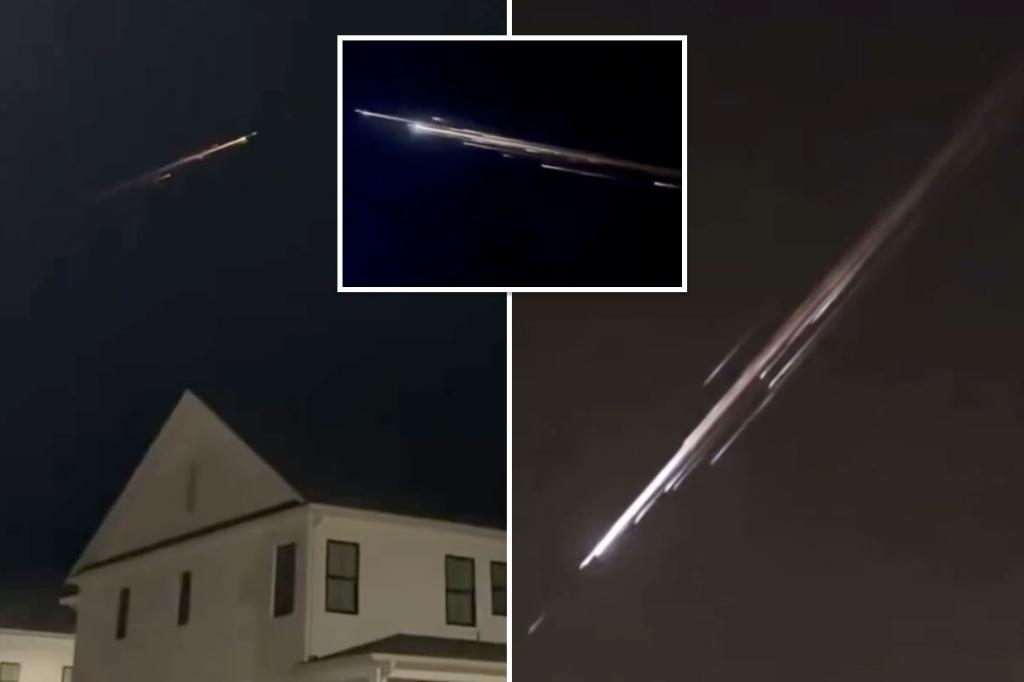On Saturday night, a celestial spectacle unfolded across the Southern sky, captivating witnesses with a dazzling display of fireballs. The event, initially shrouded in mystery and sparking speculation in the wake of recent drone sightings across the Northeast, was quickly demystified by experts. Astronomer Jonathan McDowell of the Harvard-Smithsonian Center for Astrophysics identified the source as a defunct Chinese satellite re-entering Earth’s atmosphere. The decommissioned satellite, previously utilized for imaging by the Beijing-based company SpaceView, met its fiery end above New Orleans around 10 p.m., with the resulting debris burning brightly as it traversed the skies over Mississippi, Arkansas, and Missouri.
The captivating spectacle was widely documented by awe-struck observers who shared their experiences on social media. Videos captured the dramatic descent of what appeared to be a massive shooting star, fragmenting into a cluster of smaller fireballs as the satellite disintegrated. Descriptions ranged from “amazing” trails of light to comparisons with unusual Christmas decorations, reflecting the initial bewilderment and subsequent wonder inspired by the event. While most viewers marveled at the celestial display, some voiced concerns, linking the incident to recent anxieties surrounding Chinese drones and raising questions about the potential risks posed by foreign objects in American airspace.
The re-entry of the Chinese satellite, while visually striking, is not an isolated incident. According to the National Oceanic and Atmospheric Administration (NOAA), the Earth’s atmosphere regularly encounters space debris, with an estimated 200 to 400 objects re-entering annually. The vast majority of these objects disintegrate completely before reaching the ground, and those that survive the fiery descent typically land in the ocean, posing minimal threat to populated areas. This frequent occurrence highlights the ongoing challenge of managing the growing accumulation of debris in Earth’s orbit.
The sheer volume of space debris orbiting our planet is a significant concern. NOAA estimates that approximately 30,000 pieces of space junk larger than a softball are circling the Earth, with roughly 1,000 of these objects being as large as a spacecraft. This debris, ranging from defunct satellites to discarded rocket stages and fragments from collisions, poses a potential hazard to operational satellites and spacecraft, highlighting the importance of tracking and monitoring these objects. The potential for collisions between debris and functional satellites underscores the need for international cooperation and responsible space management practices.
NASA plays a crucial role in monitoring space debris through its Space Surveillance Network. This network employs a combination of ground-based and space-based sensors to track and catalog objects in Earth’s orbit. The data collected by this network provides essential information for assessing the risk of collisions and for developing strategies to mitigate the hazards posed by space debris. This ongoing monitoring effort is vital for ensuring the safety and sustainability of space operations, protecting valuable assets in orbit, and preventing the escalation of the space debris problem.
The incident of the Chinese satellite re-entry serves as a reminder of the complexities of space exploration and the ongoing challenges associated with managing space debris. While the event itself posed no immediate threat, it underscores the need for continued vigilance and international collaboration in addressing the growing problem of orbital debris. As humanity’s presence in space continues to expand, responsible and sustainable practices are essential for preserving the space environment for future generations. The development of effective strategies for mitigating the risks posed by space debris is crucial for ensuring the long-term viability of space exploration and the continued safe operation of vital satellite systems that support life on Earth.

